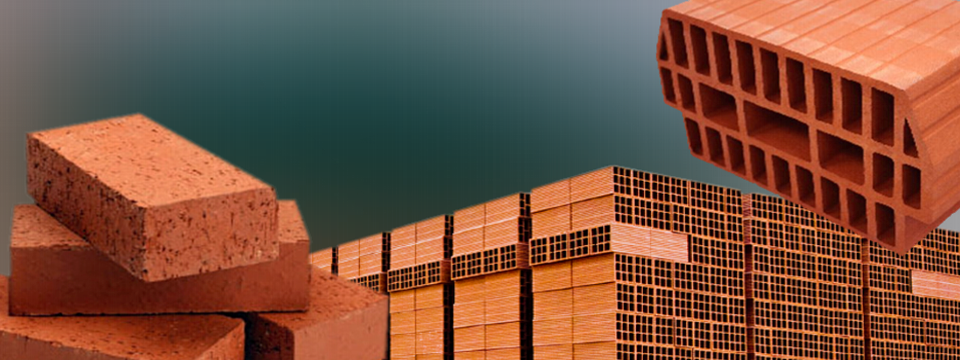![]()
Hollow bricks are one of the types of bricks, which is one of the
building materials that are used in building walls and ceilings. There
are other types of bricks used in paving floors (solid bricks) and
sloping roofs and it is called (Bricks) and other types of them are used
for lining ovens and chimneys.
The production capacity is 450 tons per day of high-quality bricks, or
the equivalent of 140,000 tons per year, and one of the remaining goals
is to increase an additional line for strapping and an additional line
for unloading by crane (Pensa), which in turn will increase the amount
of production by a large percentage.
The factory is located in the southwestern suburb of the city of Zliten
in the Shu'bah El-Rayyan region in the Cagam Valley, about ten
kilometers from the coastal road.
2. Preparatory department .
3. Department of Operation and Production .
4. Storage yard and packing of finished products.
The size of the clay atom is 0.002 mm. The clay may vary in color
depending on its components. If the clay is red, it contains a large
percentage of iron oxide, and if the color tends to yellow, then the
percentage of magnesium increases. If the clay tends from gray to dark,
this is to increase the proportion of organic materials such as carbon
and the elasticity of the clay depends on The increase in the mineral
silica and the fineness of the clay is the increase in nitrogen and the
hardness due to the increase in the organic carbon.
Clay is the main component for the manufacture of red clay and when
mixed with water, it is characterized by its flexible clay texture that
facilitates its formation. It is added to the sand mixture, which
reduces the percentage of adhesion and facilitates the process of
formation and reduces the rate of shrinkage when drying and increases
its hardness when exposed to high heat and therefore its industrial
importance increases as one of the most important materials Modern
construction.
The clay is characterized by a low porosity compared to other types of soils
with high porosity due to the bonding and cohesion of its atoms, and
this adds to it the characteristic of hardness and slow compression with
the passage of time and fluctuations of nature.
Clay is used in many industries such as building materials, insulation
materials, ceramic utensils, heating and heating tools, high melting
furnaces, and many other industries.
In the contractor factory, 2 types of bricks are made, they are bricks
for building roofs and it is called Hourdi and symbolized by the letter
H and the second type for building walls and it is called block and
symbolized by the letter B.
We manufacture 2 sizes (H) which are 16 x 25 x 40 cm, 19 x 25 x 40 cm
We manufacture 3 sizes of type B) and they are 20 x 20 x 40 cm, 15 x 20
x 40 cm, and 15 x 20 x 30 cm
Other sizes are also produced for customers with special specifications
and sizes upon request
Size H16 x 25 x 40 cm Average Weight = 7.4kg / brick
Stacking body on cart = 3 bricks x 3 bricks x 11 traits x12 sets
The number of bricks per cart = 1188 bricks
Output weight Size H16 x 25 x 40 cm per cart = 7.4 kg x 1188 bricks =
8.791 tons
Size: H19 x 25 x 40 cm, average weight = 8.35 kg / brick
Stacking body on cart = 3 bricks x 4 bricks x 9 traits x12 sets
The number of bricks per cart = 1296 bricks
Output weight Size H19 x 25 x 40 cm per cart = 8.35 kg x 1296 bricks =
10.822 tons
Size B15 x 20 x 30 cm, Average Weight = 5.50 kg / pcs
Stacking body on cart = 3 bricks x 6 bricks x 9 character x 12 sets
The number of bricks per cart = 1944 bricks
Output weight: B15 x 20 x 30 cm per cart = 05.5 kg x 1944 bricks =
10.692 tons
Size B15 x 20 x 40 cm Average Weight = 5.90 kg / 7.30 kg
Stacking body on cart = 3 bricks x 4 bricks x 9 character x 12 sets
The number of bricks per cart = 1296 bricks
Output weight: B15 x 20 x 40 cm per cart = 05.9 kg x 1296 bricks = 7.646
tons
Size B20 x 20 x 40 cm, average weight = 9.00 kg / brick
Stacking body on cart = 2 bricks x 5 bricks x 9 character x 12 sets
The number of bricks per cart = 1080 bricks
Output weight: B20 x 20 x 40 cm per cart = 9.00 kg x 1080 bricks = 7.720
tons
• Addition of connecting line and crane line (Pensa) to increase the handling capacity
and prevent the accumulation
of
ready production.
• An underground or metal tank was established to increase the storage capacity of
heavy oil to ensure continuity of
operation in the event of circumstances affecting
the refueling process from its sources at Brega Oil Marketing
Company.


